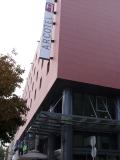
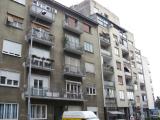
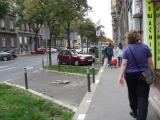
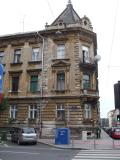
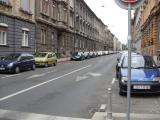
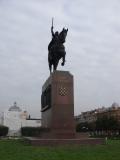
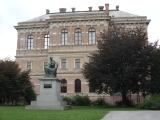
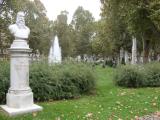
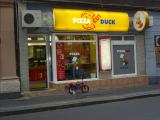
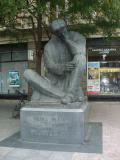
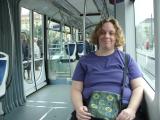
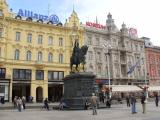

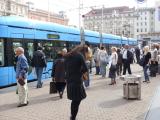
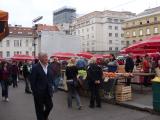
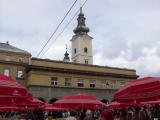
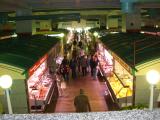
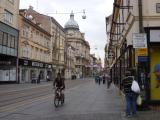
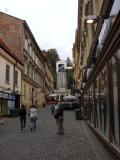
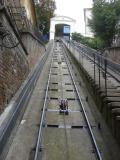
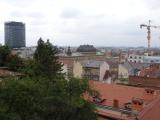
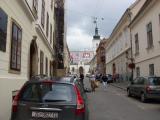
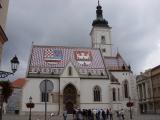
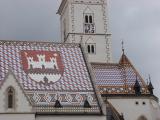
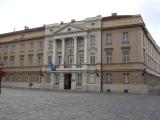
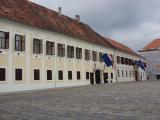
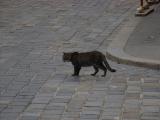
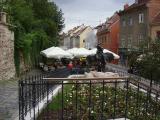
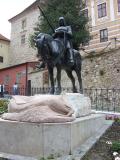
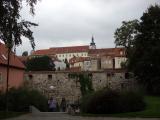
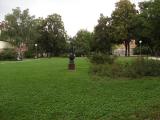
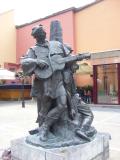
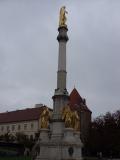
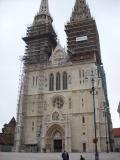
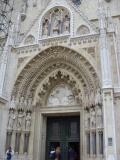
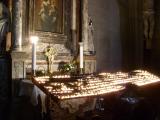
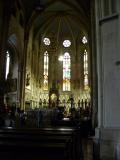
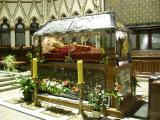
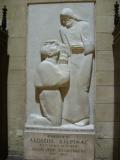
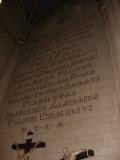
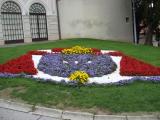
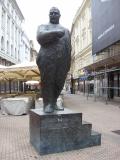
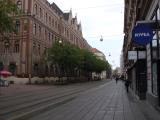
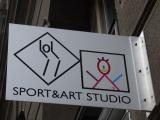
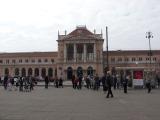
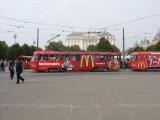
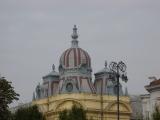
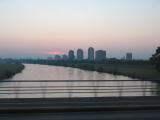
Our first stop in Croatia was the capital city of Zagreb. Zagreb is the most populous city in Croatia, with about 800,000 residents in the core city and 1.3 million in the greater metropolitan area, making it slightly smaller than Austin, Texas. Although the city can trace its history to a Roman settlement in 1 AD, it is one of the more modern cities in Croatia, and was officially chartered with the name Zagreb only in 1851. The city is full of sidewalk cafes and 19th century architecture.
These photos are copyright © 2010 Kenneth E. Harker. All rights reserved.
 |
We stayed at the Arcotel Zagreb on the Kneza Branimira, about a half kilometer (1/3 mile) east of the Zagreb glavni kolodvor (Zagreb Train Station) and less than 1 kilometer (3/5 mile) from the Zagreb autobusni kolodvor (Zagreb Bus Station). Several electric tram lines passed by the hotel, making it a convenient place to stay. |
 |
The apartment building next door to our hotel was pretty typical of apartment blocks built during the years of communist rule (1945-1991). |
 |
Our hotel was located in the lower town of central Zagreb, which had only gentle variations in elevation, and a street layout in a grid formation, so it was easy to navigate. Many of the buildings are over 100 years old. |
 |
This building was typical of the older buildings in the lower town of Zagreb. The exterior of the building has lots of missing plaster, some broken brickwork and stonework, and near the ground is covered in graffiti. Zagreb has a major problem with graffiti. |
 |
A street in the lower town of Zagreb. Portions of the town had lots of green space and trees. This street did not. |
 |
The statue of King Tomislav of Croatia (died 928) in Trg Kralja Tomislava (King Tomislav Square). Tomislav united the kingdoms of Dalmatia and Pannonia into a single kingdom in 925, establishing the first Kingdom of Croatia. The Kingdom of Croatia covered much of the present-day countries of Croatia and Bosnia and was the first unified state of the Croatian people. This statue was created by Robert Frangeš-Mihanović in 1938, but was only installed in this location in 1947. |
 |
The Hrvatska akademija znanosti i umjetnosti (the Croatian Academy of Sciences and Art) is located at the northern side of Trg J.J. Strossmayer in Donji grad, the central district of Zagreb. In front of the building is a statue of Josip Juraj Strossmayer (1815-1905). Strossmayer was a Catholic bishop and a member of the Croatian Sabor (parliament) who advocated (unsuccessfully) for the separation of Croatia from the Kingdom of Hungary. |
 |
The Trg Nikole Šubića Zrinskog is a square and park north of the Croatian Academy of Sciences and Art and south of Trg Ban Jelačić. The park is full of busts of several prominent Croatian men, but no Croatian women. This bust was of Prince Krsto Frankopan (1482-1527), who became Ban of Croatia shortly before his death. The Ban was the governor of Croatia under the rule of the Kingdom of Hungary and later the Hapsburg Emperor in Austria. |
 |
This restaurant was named "Pizza Cut Duck", which seems like a bizarre Eurospeak name. What we eventually figured out is that "pizza cut" in Croatia means "pizza by the slice". |
 |
The statue of Nikola Tesla (1856-1943) in the Donji grad. Tesla was an inventor and an electrical engineer who made some of the fundamental discoveries of electromagnetism and electrical power. He was born into a Serbian family in the town of Smiljan in the Krajina, a region of Croatia that was settled by Serbs in exchange for military service to the Austrian emperor. Tesla emigrated to the United States in 1884, eventually becoming a US citizen. Although he was ethnically Serbian, the Croatians seem willing to claim Tesla's legacy as a brilliant scientist born in Croatia. |
 |
Jen, on one of the 19 trams run by Zagrebački električni tramvaj (ZET). We purchased three-day passes and rode the trams extensively. |
 |
Trg Jelačić (Jelačić Square) is in the center of Zagreb, where the upper town and the lower town meet. The square is surrounded by 19th century buildings, and features a statue of the Ban Josip Jelačić. It was also where many tram lines converge. The buildings on the north side of the square included offices of some of the largest companies in Croatia: Allianz (an insurance company), Konzum (a supermarket chain), and Kraš (a chocolatier). |
 |
The statue of Ban Josip Jelačić (1801-1859). Jelačić was a military general and politician who became Ban of Croatia in 1848. Jelačić is remembered for his military campaigns during the Revolutions of 1848 and the abolition of serfdom in Croatia. This statue by Anton Dominik Fernkorn was erected in 1866. It originally faced north, toward Hungary, but today faces south, toward the new enemy, Serbia. |
 |
A tram makes a stop at Trg Jelačić. |
 |
North of Trg Jelačić is the Dolac Market. Above ground was an open-air market that had vendors selling fruits, vegetables, and honey. |
 |
To the west of the market was a clock tower that was part of the Crkva Sv. Marije (St. Mary's Church.) |
 |
Below the open-air market was a floor with permanent food vendors, mostly butchers, cheese shops, and bakeries. There was also a small wine shop on this floor. |
 |
Ilica was the main shopping street in downtown Zagreb. If you look closely, you can see international brands like Timberland and Adidas mixed in with more local stores. This was on Saturday afternoon, when many shops had already closed for the day. |
 |
At the end of Tomićeva is the Zagrebaška uspinjača, a funicular operated by the ZET (the same authority that operates the trams in Zagreb). The funicular is one way to get from the lower town up the hill to the upper town. It is only 66 meters (217 feet) long, making it one of the shortest public transit funiculars in the world. |
 |
The station at the top is 30.5 meters (100 feet) in elevation higher than Tomićeva, making it one of the steepest public transit funiculars in the world. The ride only takes about one minute. |
 |
A view of the lower town of Zagreb from the top of the funicular. |
 |
Even after taking the funicular to upper town, the streets could be quite steep and hilly. This is the view up Ćirilometodska, looking north toward Trg Svetog Marka (St. Mark's Square). This portion of the upper town was originally known as Gradec, and was a walled city. Gradec merged with Kotar to the east to become the new city of Zagreb in 1851. |
 |
The Crkva Sv. Marka (St. Mark's Church) is in the center of Trg Svetog Marka (St. Mark's Square) in the center of Gradec. This is a parish church in Zagreb, but holds a unique presence surrounded by government buildings. The mostly Gothic building has a very distinctive tile roof. The shield on the left is the coat of arms for the Triune Kingdom of Croatia, Dalmatia, and Slavonia (established in 1868 under the rule of the King of Hungary). The shield on the right is the coat of arms of the city of Zagreb. |
 |
The coat of arms of the city of Zagreb features a white castle on a red background. |
 |
On the east side of Trg Sv. Marka is the parliament building, the home of the Croatian Sabor. The Sabor is the unicameral legislature of Croatia. The building is flying both the flag of Croatia and the flag of the European Union, even though Croatia is not a member of the EU. Croatia applied for membership in 2003, but has still not been accepted as a member state. |
 |
On the west side of Trg Sv. Marka is Banski dvori, the building of the executive branch of government of the Republic of Croatia. It is a two-story baroque building that dates to the first half of the 19th century. The building was damaged in a rocket attack on October 7, 1991. The attack was launched by fighter jets of the Yugoslav National Army (JNA), attempting to kill Franjo Tuđman, the newly elected president of Croatia, Stipe Mesić, the president of the Presidency of Yugoslavia, and Ante Marković, the Prime Minister of Yugoslavia, the day before Croatia's official declaration of independence from the Socialist Federal Republic of Yugoslavia. One civilian was killed, but the political leaders all survived. |
 |
A cat walking through Trg Sv. Marka. This was the first of many cats we encountered in Croatia. |
 |
Walking downhill from Trg Sv. Marka, we approached Pavla radića and found this statue surrounded by flower beds. |
 |
The statue is of St. George, after he has slain the dragon. The legend of St. George and the dragon probably originated in Georgia or Armenia in the 7th century. Created by two Austrians, Kompatscher and Winder, the statue has been in Croatia since 1973 and in this location since 1994. |
 |
The skyline of the Gradec district, the old medieval walled city that would become the core of Zagreb. Only one stone gate of the old wall remains. |
 |
Opatovina Park in the upper town of Zagreb. |
 |
Vanja Radauš's 1973 bronze statue Petrica i Galženjaki depicts a minstrel playing for a condemned man. The minstrel also has a noose around his own neck. |
 |
This is the Golden Statue of Angels in front of the Zagreb Cathedral. |
 |
The two spires in the front façade of the Zagrebačka katedrala (Zagreb Cathedral) were covered in scaffolding during our visit, presumably for cleaning and repairs. The spires rise to 105 meters (344 feet) above ground, making this the tallest building in Croatia. Construction of a cathedral building on this site first began in 1093. |
 |
The main entry into the cathedral shows a lot of Gothic artistry in the stone carvings. |
 |
Inside the cathedral was a large arrangement of votive candles in front of this small shrine to the Virgin Mary, the patron saint of Zagreb. My photos inside the cathedral were taken without the flash, so they tend to make the cathedral look darker than it actually was. |
 |
The cathedral had tall stained glass windows in the apse behind the main altar. |
 |
The tomb of Cardinal Alojzije Viktor Stepinac (1898-1960), who was Archbishop of Zagreb from 1937 to 1960. An incredibly polarizing figure in the former Yugoslavia, Stepinac was Archbishop during the Second World War. In 1946, he was found guilty of having collaborated with the Ustaše and the Nazis in war crimes against the Serbs. Stepinac spent five years in jail and the remainder of his life under house arrest, during which time he was appointed a Cardinal by the Pope. Many Croats disbelieve the charges laid against Stepinac and contend that he was persecuted for refusing to form a Catholic Church in Croatia that would be loyal to Tito rather than to the Pope. In 1998, Pope John Paul II declared him a martyr of the faith and beatified him. |
 |
This relief on the wall of the Cathedral celebrating Cardinal Alojzije Viktor Stepinac (1898-1960) was donated by members of the Croatian diaspora living in the United States. |
 |
Although the photo did not turn out so well, the words carved on this wall inside the Cathedral are written in the Glagolitic script. The origin of the Glagolitic alphabet is obscure, but generally attributed to Saint Cyril and Saint Methodius, two Greek brothers who were went to Great Moravia (a Slavic state in the 9th and 10th centuries that included regions that today are parts of Hungary, Poland, Austria, Slovenia, Croatia, Serbia, Romania, Ukraine, and Germany) in 862 to proselytize Christianity. Use of the script was almost entirely replaced by the development of the Cyrillic alphabet and the propagation of the Roman alphabet during the Middle Ages, but lingered on in pockets of Croatia into the 14th century. |
 |
Flowers outside of the Zagreb Cathedral. |
 |
A statue in a modern style of Stjepan Radić (1871-1928). A Croatian nationalist politician, Radić was a founder of the Croatian Peasant Party in 1905. He opposed the creation of the first Yugoslavia after World War I, and was arrested and imprisoned twice for opposing the government that unified the Croats into a single country with the Serbs and Slovenes. On June 20, 1928, he was shot by a Montenegrin politician, Puniša Račić, during a session of the Yugoslav parliament. He died on August 8 of his injuries and became a martyr for Croatian nationalists. Today, his portrait is used on the Croatian 200 kuna banknote. |
 |
A typical street in the lower town of central Zagreb. |
 |
I found this sign unintentionally hilarious. |
 |
The Glavni kolodvor Zagreb (Zagreb Train Station) was at the southern end of the Donji grad, and many tram lines pass by the station. This station was one of the stops for the Orient Express, the long-distance train service made famous in the novel Murder on the Orient Express by Agatha Christie. |
 |
While most of the electric trams in Zagreb were plain blue, this one was covered in advertisements for McDonald's restaurants. |
 |
The roof line of a building near the train station on Antuna Mihanovića. |
 |
Driving over the bridge over the Sava River at sunset. The apartment buildings on the north shore of the river were among the tallest buildings in town. Most of Zagreb is north of the river and south of Medvednica Mountain. |
| Last Updated 1 August 2018 |